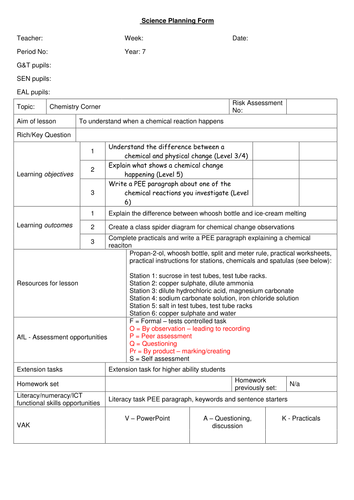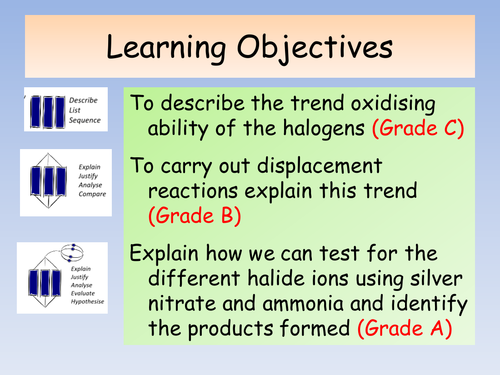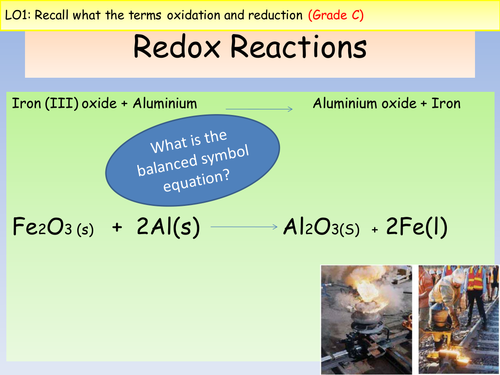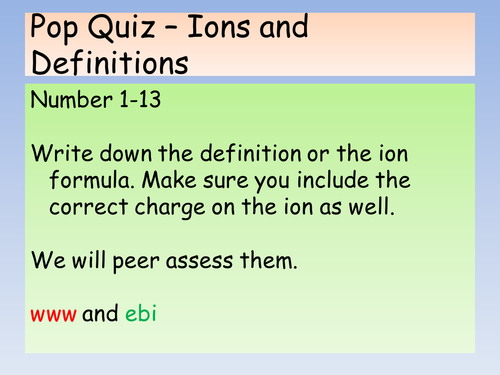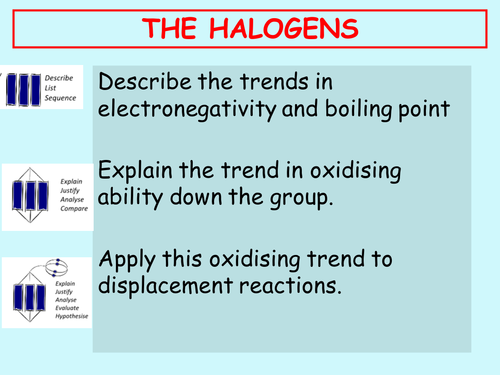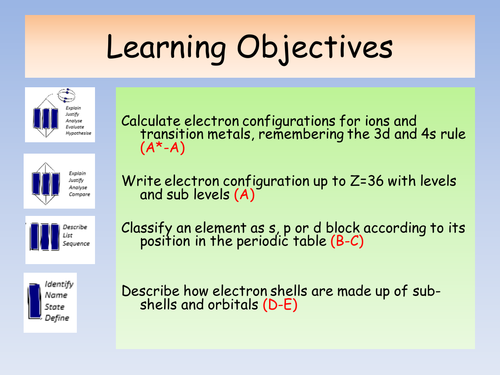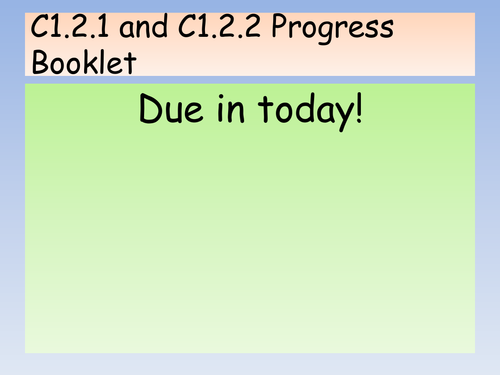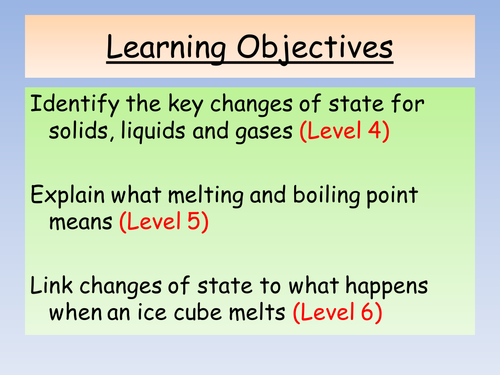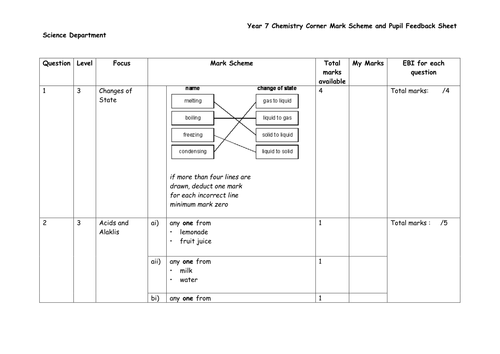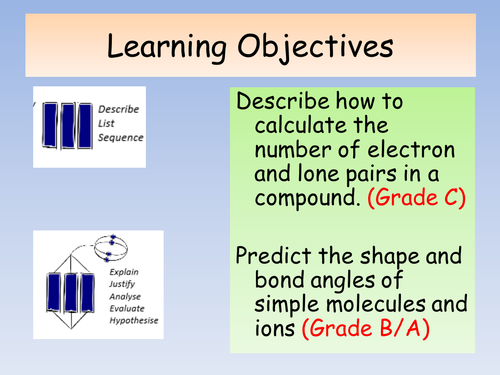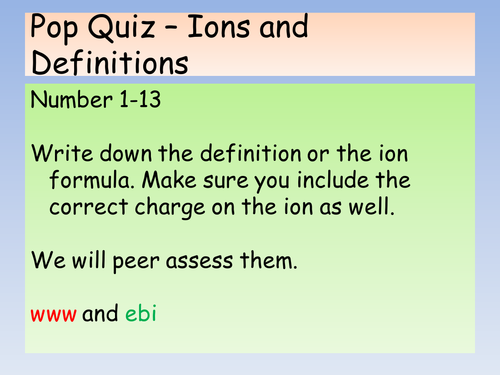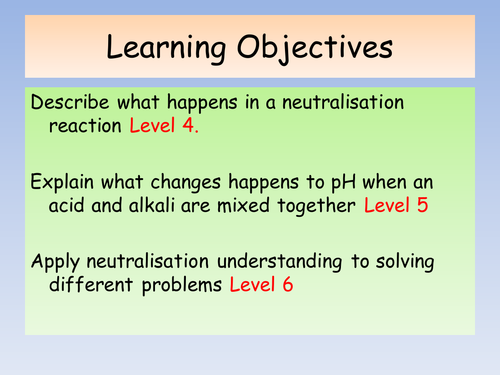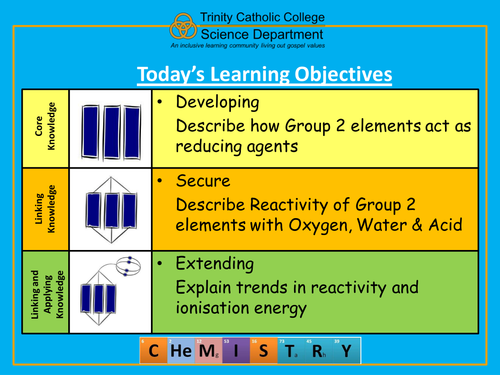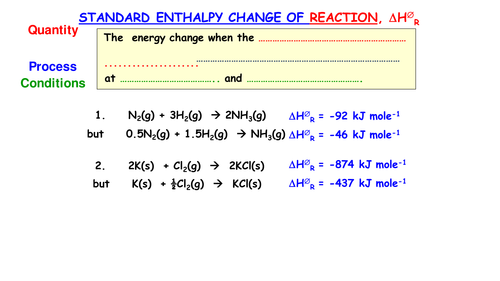
50Uploads
22k+Views
8k+Downloads
All resources

Chemistry Corner KS3 Year 7 Topic - Simple Chemical Reactions
This is the fourth and fifth lesson in a topic I made called Chemistry Corner for KS3 Year 7.
This lesson includes a powerpoint on identifying factors that suggest a reaction has happened, differences between physical and chemical reactions, a practical activity circus investigating x6 reactions and a literacy task explaining one of the practicals in the circus.
This scheme of work was made when KS3 Levels were used, so you may need to amend the levels according to your own assessment criteria used for KS3.

OCR A Level Chemistry A New Spec (from Sept 2015) - Halide ion test lesson
This is the second lesson in the Halogens topic 3.1.3 in the OCR Specification.
The powerpoint covers the displacement reaction trends, oxidising ability recap exam question and a practical sheet which covers halide ion test with silver nitrate, dilute and conc ammonia.
The lesson also includes a student practical worksheet as well as a teacher/technician worksheet.

OCR A Level Chemistry A New Spec (from Sept 2015) - Redox lesson and assessment
This is the redox lesson for Module 2 - Foundations in Chemistry.
I teach this lesson after completing PAG 2.1 with the students to consolidate their learning on Acids and Bases.
The powerpoint covers what redox means, how to calculate oxidation numbers, illustrating what is oxidised and reduced in a reaction and the exceptions.
I have also included the assessment I use called 10 for 10 (10 qs in 10 mins) which is multiple choice and I use to assess the students' learning of topics 2.1.1-2.1.5. There is a checklist on the front for students to colour code and re-read pages in the OCR textbook on the areas they need to improve.

New AQA A Level Chemistry Homework Booklet - Esters, Acid Chlorides and Acid Anhydrides
This homework booklet can be handed out at the start of the Carboxylic Acid and Derivatives section ( 3.3.9) of the New AQA A Level Chemistry Specification.
The mark scheme for the homework booklet is included as well. The homework booklet includes various exam questions both multiple choice and longer mark answer questions which cover the specification number above as well as the assessed practicals 10a and 10b.

OCR A Level Chemistry A New Spec (from Sept 2015) - Amount of Substance whole topic
Second topic in Module 2 - Foundations in Chemistry. All lessons fully resourced with powerpoints, worksheets progress sheet of the whole topic, PAG worksheets, and homework booklet with markscheme. I hand out the homework booklets at the start of every topic and collect in at the end to mark using www and ebi. The homework booklet questions have been sourced from the end of Chapter questions within the OCR textbook and typed up as no electronic copy was available. The mark scheme corresponds to the OCR pages in the textbook as well.
This is the whole topic for Amount of Substance (I've planned for 8 lessons but it often takes longer!) fully resourced 2.1.3 according to the OCR Specification.
SOLO symbols are used to differentiate between tasks. Hope you find it useful and please let me know of any suggestions or improvements. More topics to follow!

OCR A Level Chemistry A New Spec (from Sept 2015) - The Halogens lessons
There are 4 lessons here covering the whole The Halogens, 3.1.3 in the OCR specification.
Lesson 1 covers - Physical trends of the Halogens and displacement reactions. There is a teacher and student practical sheet included.
Lesson 2 covers - Halide ion tests including a teacher and practical sheet.
Lesson 3 covers - Disporportionation and the uses of chlorine including an ethical discussion using greenpeace and WHO articles for a literacy task.
Lesson 4 - PAG 4.2 Teacher and student worksheets

OCR A Level Chemistry A New Spec (from Sept 2015) - Electrons, Bonding and Structure whole topic
2.2 topic in Module 2 - Foundations in Chemistry. All lessons fully resourced with powerpoints, worksheets and homework booklet with markscheme. I hand out the homework booklets at the start of every topic and collect in at the end to mark using www and ebi. The homework booklet questions have been sourced from the end of Chapter questions within the OCR textbook and typed up as no electronic copy was available. The mark scheme corresponds to the OCR pages in the textbook as well.
This is the whole topic for Electrons, Bonding and Structure fully resourced 2.2.1-2.2.2 according to the OCR Specification.
SOLO symbols are used to differentiate between tasks. Hope you find it useful and please let me know of any suggestions or improvements. More topics to follow!

OCR A Level Chemistry A New Spec (from Sept 2015) - Determination of Formulae lesson
This is the second lesson in the Amount of Substance topic in Module 2 - Foundations in Chemistry.
The powerpoint covers empirical and molecular formula, relative molecular mass, hydrated salts and water of crystallisation.
The worksheets will help with empirical formulae calculations (there is a help sheet if needed for weaker students) however there is also a stretch and challenge task on Ions for higher ability students to complete to differentiate.
The practical activity helps bring together empirical formula and water of crystallisation but also helps prepare students for PAG 1.3 prior to them completing their first PAG.

OCR A Level Chemistry A New Spec (from Sept 2015) - Mass Spectrometry lesson
Second Lesson I use as part of the topic Atomic Structure and Isotopes in Module 2 - Foundations in Chemistry.
The lesson reviews Isotopes and ions from the first lesson then goes onto relative isotopic mass and relative atomic mass. It also covers how to identify an element from its mass spectrum and calculating RAM.
OCR new spec does not need to know how a mass spectrometer works but I have some basic information in there to help understanding of what happens.

Chemistry Corner KS3 Year 7 Topic - Changes of State lesson
This is the second lesson in a topic I made called Chemistry Corner for KS3 Year 7.
This lesson includes a powerpoint on changes of state (I always purchase some dry ice to demonstrate sublimation in class), properties of solids liquids and gases as well as melting and boiling points. There are also differentiated activity sheets and an extension task on icebergs.
This scheme of work was made when KS3 Levels were used, so you may need to amend the levels according to your own assessment criteria used for KS3.

Chemistry Corner KS3 Year 7 Topic - End of Topic Test & Progress Planner
This is the end of topic assessment for the Chemistry Corner scheme of work.
There is also a front cover sheet using teacher and student assessment boxes for www and ebi. I have also included the progress planner to show the overall structure of the topic that students can stick into their books.
There is also a mark scheme and raw mark to level converter, however this scheme of work was made when KS3 Levels were used, so you may need to amend the levels according to your own assessment criteria used for KS3.

OCR A Level Chemistry A New Spec (from Sept 2015) - Displacement reactions of Halogens lesson
This is the first lesson in the Halogens topic 3.1.3 in the OCR Specification.
The powerpoint covers the physical properties of the Halogens, trends in boiling points, oxidising ability and displacement reactions.
The lesson also includes a student practical worksheet as well as a teacher/technician worksheet.

New AQA A Level Chemistry lesson - Acyl Chlorides
This lesson introduces the key ideas of Acyl Chlorides and will cover one lesson's worth of content. The powerpoint covers:
IUPAC rules for naming acyl chlorides
The 4 different reaction processes that acyl chlorides undergo.
The products and reactants needed for the 4 different acyl chloride reactions
The reaction mechanism for Acyl Chlorides is not covered in this single lesson powerpoint but another resource. This lesson is based on the New AQA A Level Chemistry specification.

OCR A Level Chemistry A New Spec (from Sept 2015) - Shapes of molecules lesson
This is lesson 4 in the Electrons, bonding and structure topic in Module 2 - Foundations in Chemistry.
The powerpoint covers bonding pairs vs lone pairs repulsion, drawing simple shapes and a rule list for helping determine how many LP and BP and therefore what shape is produced. It also goes onto multiple bonds. I encourage the use of molymod kits for this lesson too, which helps with the 3D aspect of bonding.

OCR A Level Chemistry A New Spec (from Sept 2015) - The mole and Avogadro's constant lesson
This is the first lesson in the second topic The Amount of Substance in Module 2 - Foundations in Chemistry.
The powerpoint covers Avogadro's constant, the mole, molar mass and re-arranging the molar mass equation.
The activity is a good task to get students to understand what a mole is in terms of the number of atoms in your signature. The worksheets help introduce standard form and sig fig if needed to practice Maths skills as well as practicing re-arranging the molar mass equation.

Chemistry Corner KS3 Year 7 Topic - Neutralisation Reactions
This is the eighth lesson in a topic I made called Chemistry Corner for KS3 Year 7.
This lesson includes a powerpoint on introducing neutralisation reactions using a rainbow fizz demonstration, general word equations, students doing their own mini neutralisation reaction, neutralisation problems such as nettle stings etc.
This scheme of work was made when KS3 Levels were used, so you may need to amend the levels according to your own assessment criteria used for KS3.

OCR A Level Chemistry A New Spec (from Sept 2015) - Group 2 lesson
This is a lesson covering Group 2 elements, 3.1.2 in the OCR specification.
The powerpoint includes physical and chemical trends of group 2 metals. There is also a practical sheet which covers reactions of group 2 oxides, hydroxides and thermal decomposition of group 2 carbonates.

New AQA A Level Chemistry Thermodynamics Lesson 1
This lesson is used as an initial recap on the Year 12 content on Energetics before starting the Thermodynamics topic fully from the new AQA A Level Chemistry topic 3.1.8
The powerpoint includes a variety of different energetics questions from Year 12 which can be distributed around the room as a circus of self assessment questions. Answers and mark schemes are included for each question, definition etc. The questions cover Enthalpy of formation, combustion and reaction, Calorimetry questions, Average bond enthalpies and Hess Cycles for formation and combustion.
Also included is a simple worksheet on exothermic and endothermic reactions which can be used as part of the circus as well.
At the end of the lesson students can highlight calculation areas they need to review from Year 12 from Energetics prior to starting the Thermodynamics topic. Also included is a list of the required definitions needed to know for the Thermodynamics topic which can be handed to students ready for pop quiz definition tests throughout the topic.

OCR A Level Chemistry A New Spec (from Sept 2015) - Ionic and covalent bonding lessons
These are lessons 2 and 3 in the Electrons, bonding and structure topic in Module 2 - Foundations in Chemistry.
The ionic bonding powerpoint covers drawing ionic compounds and writing formulas and the behaviour of ionic compounds.
The covalent bonding powerpoint covers drawing covalent compounds, properties of simple covalent compounds and dative covalent bonding.

Chemistry Corner KS3 Year 7 Topic - Properties of Metals Lesson
This is the third lesson in a topic I made called Chemistry Corner for KS3 Year 7.
This lesson includes a powerpoint on what the word properties mean, explaining key properties of metals, creative thinking task on properties which involves a whole class activity. The students rate their learning at the end of the lesson as well.
This scheme of work was made when KS3 Levels were used, so you may need to amend the levels according to your own assessment criteria used for KS3.

